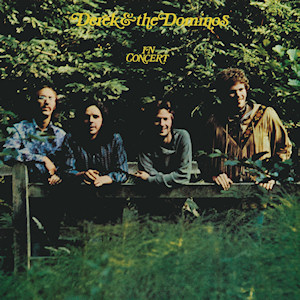His record company, of course, was happy to keep their golden boy on the racks, starting with 1972’s The History Of Eric Clapton, which compiled a chronological journey through tracks from his days with the Yardbirds, John Mayall, Cream, Blind Faith, Delaney & Bonnie, and the two solo albums. Rarities included the single version of “Tell The Truth” and a jam of same from the Layla sessions, plus off tracks with Jimmy Page, Steve Winwood, and King Curtis.
A reissue of “Layla” as a single boosted sales of its parent album, so in the absence of a studio release, a double live album engineered by Eddie Kramer at the Fillmore East in October 1970, just before Layla’s release, became the second Derek and the Dominos album. While it may seem like a quick cash-in, it’s actually a decent record. Without Duane in the room, and in contrast to the crowded stages with Delaney & Bonnie and Joe Cocker’s Mad Dogs & Englishmen, the quartet leans on economy and delivers. They were all pros, after all. Because they can, each track leads to soloing and more soloing; most exceed eight minutes.
An extended drum groove with only the slightest accents from the other band members turns into “Why Does Love Got To Be So Sad”. The extreme stereo separation has Bobby’s vocal and organ on the left and Eric on the right, with Carl and Jim bouncing in the middle, and it’s a crisp mix. “Got To Get Better In A Little While” would have been featured on their second album if they’d finished it, but here it’s a 14-minute boogie with some energetic piano and plenty of wah-wah.
Rather than recycle the Layla album wholesale, the band touches on earlier Clapton showcases. “Let It Rain” cascades for over 17 minutes, though a third of that is the drum solo. The crowd goes wild. “Presence Of The Lord” was sung by Steve Winwood on the Blind Faith album, but Eric strains to reach the notes here. Bobby harmonizes here and there, which helps. “Tell The Truth” doesn’t have the drive of the album version, and much of it is a jam on a single chord, but Bobby is a better vocal foil on “Bottle Of Red Wine”.
“Roll It Over” would have only been known to those who’d found the swiftly deleted single from a few months before; this is a decent performance and worthy of release. “Blues Power” has another moody intro the belies the boogie that follows, but the band navigates the stops and starts well and Eric’s fast chordal riffing propels the tune over the too-long ending. When it finally does, it’s right into the much slower “Have You Ever Loved A Woman” for plenty of fretwork.
In the digital era, the album was mostly ignored, possibly because of Clapton’s own disinterest. But some twenty years after its original release, after Eric had experienced more than a few comebacks along with the runaway success of his Unplugged special and album, his old label compiled an upgrade of sorts as Live At The Fillmore. Six of the songs from In Concert were repeated in a new sequence, interspersed with two tracks repeated from Clapton’s Crossroads box set and five performances appearing for the first time. Different versions of “Why Does Love Got To Be So Sad”, “Tell The Truth”, and “Let It Rain” provide different perspectives, while “Crossroads”, “Key To The Highway”, and “Nobody Knows You When You’re Down And Out” go deeper into the blues. “Little Wing” gains poignancy due to Jimi Hendrix’s death a month before. The liner notes kindly noted which of the two shows used spawned each track, though Anthony DeCurtis should have known how to spell Delaney Bramlett’s first name. Photos from the actual shows are nice too.
Derek & The Dominos In Concert (1973)—3½
Derek and the Dominos Live At The Fillmore (1994)—3½


No comments:
Post a Comment